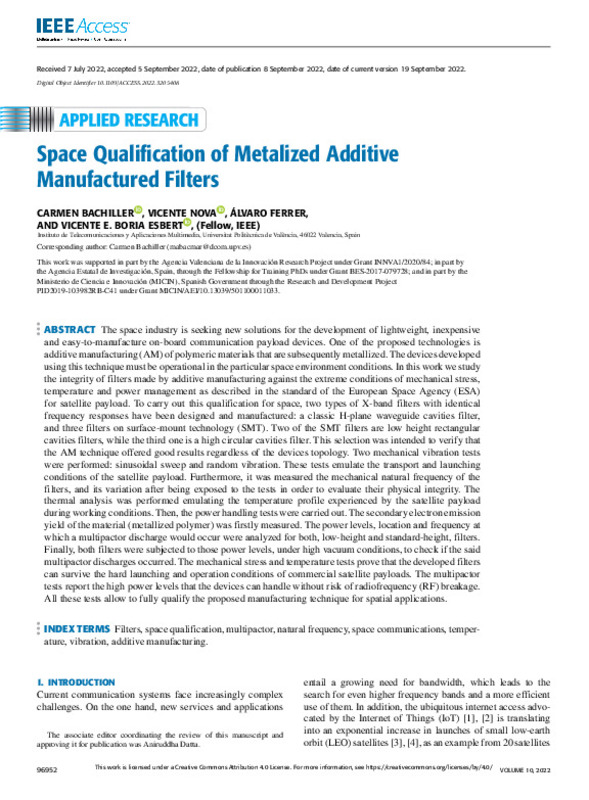|
Resumen:
|
[EN] The space industry is seeking new solutions for the development of lightweight, inexpensive and easy-to-manufacture on-board communication payload devices. One of the proposed technologies is additive manufacturing ...[+]
[EN] The space industry is seeking new solutions for the development of lightweight, inexpensive and easy-to-manufacture on-board communication payload devices. One of the proposed technologies is additive manufacturing (AM) of polymeric materials that are subsequently metallized. The devices developed using this technique must be operational in the particular space environment conditions. In this work we study the integrity of filters made by additive manufacturing against the extreme conditions of mechanical stress, temperature and power management as described in the standard of the European Space Agency (ESA) for satellite payload. To carry out this qualification for space, two types of X-band filters with identical frequency responses have been designed and manufactured: a classic H-plane waveguide cavities filter, and three filters on surface-mount technology (SMT). Two of the SMT filters are low height rectangular cavities filters, while the third one is a high circular cavities filter. This selection was intended to verify that the AM technique offered good results regardless of the devices topology. Two mechanical vibration tests were performed: sinusoidal sweep and random vibration. These tests emulate the transport and launching conditions of the satellite payload. Furthermore, it was measured the mechanical natural frequency of the filters, and its variation after being exposed to the tests in order to evaluate their physical integrity. The thermal analysis was performed emulating the temperature profile experienced by the satellite payload during working conditions. Then, the power handling tests were carried out. The secondary electron emission yield of the material (metallized polymer) was firstly measured. The power levels, location and frequency at which a multipactor discharge would occur were analyzed for both, low-height and standard-height, filters. Finally, both filters were subjected to those power levels, under high vacuum conditions, to check if the said multipactor discharges occurred. The mechanical stress and temperature tests prove that the developed filters can survive the hard launching and operation conditions of commercial satellite payloads. The multipactor tests report the high power levels that the devices can handle without risk of radiofrequency (RF) breakage. All these tests allow to fully qualify the proposed manufacturing technique for spatial applications.
[-]
|
|
Agradecimientos:
|
This work was supported in part by the Agencia Valenciana de la Innovacion Research Project under Grant INNVA1/2020/84; in part by the Agencia Estatal de Investigacion, Spain, through the Fellowship for Training PhDs under ...[+]
This work was supported in part by the Agencia Valenciana de la Innovacion Research Project under Grant INNVA1/2020/84; in part by the Agencia Estatal de Investigacion, Spain, through the Fellowship for Training PhDs under Grant BES-2017-079728; and in part by the Ministerio de Ciencia e Innovacion (MICIN), Spanish Government through the Research and Development Project PID2019-103982RB-C41 under Grant MICIN/AEI/10.13039/501100011033.
[-]
|









